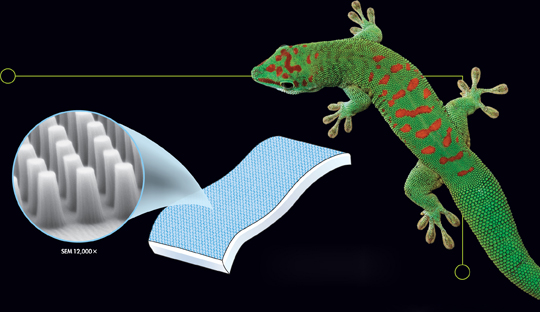Technology & Biology
A Nature-Inspired Adhesive
People who keep geckos as pets have always marveled at the way these little lizards can climb up vertical surfaces, even smooth glass walls, and then hang on by a single toe despite the pull of gravity. How do they do it? No, they do not have some sort of glue on their feet and they don't have suction cups. Incredibly, they use van der Waals forces.
A gecko foot is covered by as many as half a million tiny hairlike projections. Each projection is further divided into hundreds of tiny, flat-surfaced fibers. This design allows the gecko's foot to come in contact with an extremely large area of the wall at the molecular level. Van der Waals forces form between molecules on the surface of the gecko's foot and molecules on the surface of the wall. This allows the gecko to actually balance the pull of gravity.
If it works for the gecko, why not for us? That's the thinking of researchers at the Massachusetts Institute of Technology, who have now used the same principle to produce a bandage. This new bandage is held to tissue by van der Waals forces alone. Special materials make it possible for the new bandage to work even on moist surfaces, which means that it may be used to reseal internal tissues after surgery. By learning a trick or two from the gecko, scientists may have found a way to help heal wounds, and even save lives in the process.

The surface of the new bandage mimics the surface of the gecko foot at the microscopic level.
WRITING
Suppose you are a doctor reviewing this new bandage for its potential applications. In what ways might you use such a bandage? Present your ideas as a list.
Table of Contents
- Formulas and Equations
- Applying Formulas and Equations
- Mean, Median, and Mode
- Estimation
- Using Measurements in Calculations
- Effects of Measurement Errors
- Accuracy
- Precision
- Comparing Accuracy and Precision
- Significant Figures
- Calculating With Significant Figures
- Scientific Notation
- Calculating With Scientific Notation
- Dimensional Analysis
- Applying Dimensional Analysis




